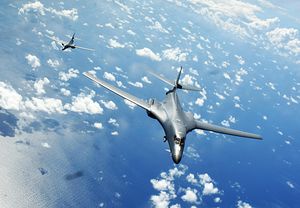The U.S. Air Force (USAF) dispatched two B-1B Lancer heavy strategic bombers from Andersen Air Force Base on Guam in the Western Pacific to the South China Sea on a ten-hour training mission on June 8, U.S. Pacific Command announced in a press statement last week.
The two B-1B Lancers, of USAF’s 9th Expeditionary Bomb Squadron (7th Bomb Wing), operated in conjunction with the U.S. Navy’s Arleigh Burke-class guided missile destroyer USS Sterett. “The joint training, organized under Pacific Command’s continuous bomber presence program (CBP), allows the Air Force and Navy to increase interoperability by refining joint tactics, techniques and procedures while simultaneously strengthening their ability to seamlessly integrate their operations,” the statement reads.
B-1Bs of the 9th Expeditionary Bomb Squadron deployed to the Asia-Pacific in support of United States Pacific Command’s continuous bomber presence mission in the region this February. The unit replaced B-1B bombers and over 300 airmen from the 34th Expeditionary Bomb Squadron (28th Bomb Wing), which deployed to Guam from Ellsworth Air Force Base, South Dakota in August last year–the first deployment of B-1B bombers to Guam in over a decade.
“The supersonic Lancers replaced the base’s fleet of B-52H long-range heavy bombers,” I explained in February. “The USAF has routinely been stationing B-1, B-52H, and B-2 Spirit bombers in Guam since 2004.” The B-1Bs stationed on Guam “will provide a significant rapid global strike capability that enables readiness and commitment to deterrence, offers assurance to the U.S. allies and strengthens regional security and stability in the region,” according to a Pentagon press release from February 2017.
“The USAF’s 62 B-1B Lancers are capable of carrying up to 75,000 pounds (34,000 kilograms) of weapons—the largest payload of both guided and unguided weapons in the USAF’s inventory. Though heavily armed, the bomber can reach a top speed of Mach 1.2 and can operate at altitudes above 30,000 feet (9,100 meters),” as I explained elsewhere.
China said that it remains vigilant as the United States is stepping up its military presence in the disputed waters. “China always maintains vigilance and effective monitoring of the relevant country’s military activities in the South China Sea,” China’s Ministry of Defense said in a statement on June 9, referring to the B-1B training flights. “China’s military will resolutely safeguard national sovereignty, security and regional peace and stability,” it added.
B-1Bs stationed on Guam participated in a number of training exercises and deterrence patrols in the region over the last months, especially in East Asia. A B-1B bomber conducted training missions with the Japan Air Self-Defense Force (JASDF) F-15J Eagles fighter jets and Republic of Korea Air Force (ROKAF) Slam Eagles and F-16s fighter jets in March.
“In September 2016, one supersonic B-1B Lancer heavy strategic bomber, escorted by USAF F-16 fighter jets and Republic of Korea Air Force (ROKAF) F-15K aircraft performed a low-level flight near the Demilitarized Zone (DMZ) on the Korean Peninsula and landed at Osan Air Base in South Korea,” I reported in February. “It was the closest a B-1B Lancer has ever flown to the border separating North and South Korea.”

































